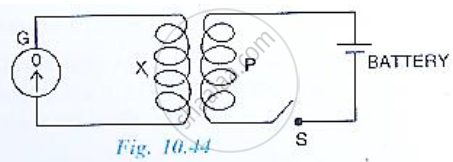Advertisements
Advertisements
प्रश्न
A power transmission line feeds input power at 2300 V to a stepdown transformer with its primary windings having 4000 turns. What should be the number of turns in the secondary in order to get output power at 230 V?
उत्तर
Input voltage, V1 = 2300
Number of turns in the primary coil, n1 = 4000
Output voltage, V2 = 230 V
Number of turns in secondary coil = n2
Voltage is related to the number of turns as:
`"V"_1/"V"_2 = "n"_1/"n"_2`
`2300/230 = 4000/"n"_2`
n2 = `(4000 xx 230)/2300` = 400
Hence, there are 400 turns in the second winding.
APPEARS IN
संबंधित प्रश्न
The following diagram in Fig. 10.44 shows a coil X connected to a sensitive centre –zero galvanometer G and a coil P connected to a battery through a switch S.

(a) Describe the observation when the switch S is (i) closed suddenly, (ii) then kept closed, (iii) finally opened.
(b) Name and state the law which explains the above observations.
How are the e.m.f in the primary and secondary coils of a transformer related with the number of turns in these coils?
The primary coil of a transformed has 800 urns and the secondary coil has 8 turns. It is connected to a 220 V a.c. supply. What will be the output voltage?
What is the function of a step-up transformer?
(i) Draw a clear labelled diagram of an electric bell.
(ii) Explain in brief, its working.
(iii) What material is used for the core of an electric bell? State the reason.
In a transformer, the number of turns in the primary and the secondary are 410 and 1230 respectively. If the current in primary is 6A, then that in the secondary coil is
Give the advantage of AC in long distance power transmission with an illustration.
Find out the phase relationship between voltage and current in a pure inductive circuit.
The output power in step-up transformer used in practice is ______.
A transformer works on the principle of ______.
